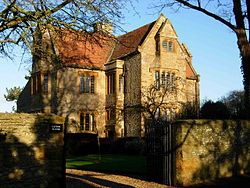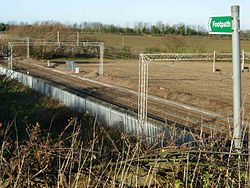Gayton, Northamptonshire
| Gayton | |
| Northamptonshire | |
|---|---|
 Gayton Manor | |
| Location | |
| Grid reference: | SP704547 |
| Location: | 52°11’6"N, -0°58’26"W |
| Data | |
| Population: | 544 (2011) |
| Post town: | Northampton |
| Postcode: | NN7 |
| Dialling code: | 01604 |
| Local Government | |
| Council: | West Northamptonshire |
| Parliamentary constituency: |
Daventry |
Gayton is a rural village in Northamptonshire, five miles south-west of Northampton town centre. It stands on a hill close to the larger villages of Bugbrooke, Milton Malsor and Blisworth, with a linked public footpath network.
The 2011 Census recorded the parish population as 544.
Parish church

The Church of England parish church is St Mary The Virgin. The base of the tower and font are Norman[1] though the upper part of the tower is19th century.
The church contains six misericords dating from the 14th and 15th century, unusually, some of these have been modified at a later date, possibly by foreign carvers. There are monuments to Sir Philip and Scholastica de Gayton, Sir Francis Tanfield and his wife and also Mabila de Murdak, (14th century).[2]
History
The village's name is probably derived from Old English meaning "Gæga's farm/settlement".[3] The first record of the name is from 1162.[4]
This village is sited near the ancient Roman road known as Watling Street.
Gayton is not recorded in the Domesday Book survey of 1086 but may be the unnamed settlement in the Hundred of Towcester held by the knight Sigar of Chocques, who came from the village of that name near Béthune in the north of France. In 1242 Robert VII of Béthune sold the manor along with virtually all his other English properties to Robert of Guines, who in turn in 1248 sold it to Ingram of Fiennes, who in 1270 passed it to Michael of Northampton, a cleric.[5]
Sir Philip de Gayton (d.1316),[2] had two daughters, Scholastica de Gayton (d.1354),[2] who married Godfrey de Meaux, and Julianna, who had a child, Mabila, with her husband Thomas de Murdak. Juliana murdered her husband Thomas in 1316 with the assistance of family servants, and later married one of the servants, John de Veaux. They were tried for murder in 1321, and Juliana was hanged at Tyburn. The facts of this tale have become somewhat confused over the centuries but the de Gayton tombs are in the village church.[1] Another version is that Scholastica murdered her husband and her sister Julianna was burnt as a witch.[6]
Sir Francis Tanfield (d. 1558),[2] built the Manor House in the village according to one source although another source dates it later in the century. [7][2] This house has some similarity to Sir Thomas Tresham's at Lyveden New Bield (begun by 1594[8])
Industry
There were three brickyards in the parish,[1] now all gone and filled in with domestic refuse.
The parish was also a source of ironstone which was quarried to the south-east of the village, either side of the road to Blisworth up to and just beyond the crossroads with the road from Tiffield to Milton Malsor. The quarries began operation in about 1853 and continued to 1921 with possibly a break round about 1900. The quarries began close to the village and worked their way towards Blisworth as the ore was worked out. Quarrying was by hand with the aid of explosives. The ore was taken away by narrow gauge tramways in wagons pulled by horses for most of that time but a steam locomotive and a petrol engined locomotive were used from 1918. For the most part these tramways led to a standard gauge branch railway which ran from north east of the Gayton-Blisworth road to the main line with a junction facing Nether Heyford. This branch was at various times worked by horses or a steam locomotive. However one of the quarries, which operated between 1863 and 1884 had a tramway which led to another railway. This was the line from Blisworth to Towcester which was built in 1866. This line ran parallel to the earlier branch for most of the earlier branch's course and just to the east of it, but the junction with the main line faced Blisworth Station, rather than Heyford. The wagons from this quarry were lowered down the side of the cutting for the ore be loaded into standard gauge wagons. Until 1891 the ore from Gayton was smelted at Nether Heyford Ironworks but after this closed it was taken elsewhere. More modern quarries at Blisworth had a rail connection with the Northampton Towcester line nearer to Blisworth Station.
One gullet is left and there are remains of some tramway bridges. Some of the quarried fields are now at a lower level than the roads. The quarried land has been restored to agriculture for the most part.[9]
About the village

The village hasa village hall and a primary school, Gayton Church of England Primary School
There is one pub. The Eykyn Arms is named after Roger Eykyn who live at Gayton House (probably 18th century, demolished 1972).[2] The Queen Victoria Pub closed in 2016 and in 2017 it was proposed to turn it into flats.[10][11]
There is a village green with a children's play area.
Gayton is close to the Grand Union Canal, and at Gayton Junction is a marina. Here an arm of the canal goes down to Northampton through a long flight of locks at Rothersthorpe.
The village is also close to the West Coast Main Line, one of the main railway routes between London and Lancashire.
The site of a Roman building, which may have been a temple, is about 800 yards south-eastTemplate:Clarify of the village and was excavated in 1840 revealing a bronze statue and 4th-century coins.[2]
Outside links
| ("Wikimedia Commons" has material about Gayton, Northamptonshire) |
References
- ↑ 1.0 1.1 1.2 "Chronicle & Echo, Northampton, article on Gayton, 23 July 2007". Chronicle & Echo, Northampton. http://www.northamptonchron.co.uk/clive-holmes/Gayton.3051986.jp. Retrieved 2008-10-29.
- ↑ 2.0 2.1 2.2 2.3 2.4 2.5 2.6 Nikolaus Pevsner: The Buildings of England: Northamptonshire, 1961; 1973 Penguin Books ISBN 978-0-300-09632-3page 221–223
- ↑ "Key to English Place-Names". University of Nottingham. http://kepn.nottingham.ac.uk/map/place/Northamptonshire/Gayton.
- ↑ Mills, Anthony David: 'A Dictionary of British Place-Names' (Oxford University Press, 2003) ISBN 978-0-19-852758-9
- ↑ Farrer, William (1923). "Honors and knights' fees: an attempt to identify the component parts of certain honors and to trace the descent of the tenants of the same who held by knight's service or serjeanty from the eleventh to the fourteenth century". Manchester. p. 50. https://books.google.com/.
- ↑ "Walk 110 Gayton Circle". https://northamptonshirewalks.co.uk/about/four-churches/.
- ↑ Mee, Arthur: The King's England: Northamptonshire (Hodder & Stoughton)
- p 144
- ↑ Nikolaus Pevsner: The Buildings of England: Northamptonshire, 1961; 1973 Penguin Books ISBN 978-0-300-09632-3page 300
- ↑ Tonks, Eric (April 1989). The Ironstone Quarries of the Midlands Part 3: The Northampton Area. Cheltenham: Runpast Publishing. p. 31–39. ISBN 1-870-754-034.
- ↑ "What Pub: Queen Victoria". https://whatpub.com/pubs/NTH/97/queen-victoria-gayton.
- ↑ "Queen Victoria, Gayton". https://www.closedpubs.co.uk/northamptonshire/gayton_queenvictoria.html.
